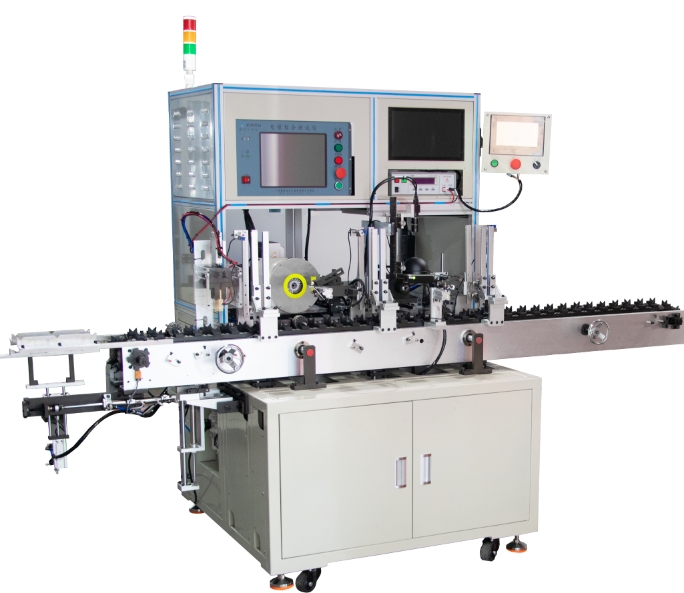What are the common mechanical failures and solutions for motor motor fully automatic rotor test vision all-in-one machine?
Mechanical failures of motor motor automatic rotor test vision integrated machine may affect the precision and efficiency of equipment operation, and even lead to production stagnation. The following is a detailed analysis of common mechanical failures and their solutions:
1, rotor clamping positioning failure
Failure phenomenon: After the rotor is clamped, the position of the test process is shifted, resulting in inaccurate test data, such as concentricity of the rotor is too poor, axial positioning deviation, etc.; clamping can not be stabilized and fixed the rotor, there is a loosening phenomenon.
Reason analysis: long-term use of fixtures, clamping jaws, positioning blocks and other parts of the wear, resulting in insufficient clamping force or decreased positioning accuracy; fixture installation position offset, not in strict accordance with the requirements of the equipment calibration; clamping mechanism of the transmission components, such as screws, guide rails, etc., failure, resulting in the movement of the jaws do not fall into place.
Solution: check the wear of the fixture, the serious wear of the clamping jaws, positioning blocks and other components for replacement; the use of professional measuring tools, such as micrometers, etc., to calibrate the installation position of the fixture to ensure that the installation accuracy; check the drive components of the clamping mechanism, clean up the silk rod, guide impurities on the rail, add lubricating oil, if the silk rod, the guide rail is seriously worn, it will be replaced.
2, the movement of parts stuck or abnormal sound
Failure phenomenon: the linear motion parts of the equipment, such as table, slide, etc. in the process of moving the jam, resulting in smooth movement, affecting the test efficiency; movement accompanied by abnormal friction, impact sound and other noise.
Reason analysis: guide rail, screw and other moving parts surface impurities, iron filings, etc., hindering the normal movement of the components; guide rail, screw lubrication is poor, insufficient lubricant or lubricant deterioration; the installation of moving parts is not accurate enough, such as the parallelism of the guide rail, straightness is too poor, resulting in uneven force on the components.
Solution: clean up the impurities and iron filings on the surface of the guide rail, screw and other moving parts after stopping the machine; regularly check the status of the lubricant, and supplement or replace the lubricant in time; readjust the installation accuracy of the moving parts, and use high-precision measuring instruments, such as laser interferometers, etc., to ensure that the parallelism and straightness of the guide rail meets the requirements of the equipment.

3、Drive system failure
Failure phenomenon: belt transmission system, the belt slipping phenomenon, resulting in power transmission failure; gear transmission system, gear wear and tear is serious, transmission is not stable, noise and other issues; chain transmission system, the chain is loose, jump teeth, affecting the normal operation of the equipment.
Reason analysis: the belt is used for too long, aging, wear, resulting in insufficient belt tension; gear transmission process, lubrication is not sufficient, the friction between the gears increases, resulting in wear; chain long-term operation, not timely tensioning adjustment, or the chain connection parts loose.
Solution: Replace the aging and worn belts, and adjust the tension of the belts to the appropriate state; adequate lubrication of the gear drive system, regularly clean the impurities and iron filings on the surface of the gears, check the wear and tear of the gears, and replace them when they are seriously worn; adjust the tension of the chain, check the connecting parts of the chain such as links, pins, etc., and replace the loosened or damaged parts.
4、Vision system mechanical structure failure
Failure phenomenon: the camera bracket is loose, resulting in changes in the shooting angle, affecting the accuracy of visual inspection; light source mounting bracket shaking, resulting in uneven illumination, image quality degradation.
Cause analysis: camera bracket, light source bracket fixing screws loose; bracket material or structural design is unreasonable, in the process of equipment operation can not withstand vibration and external forces.
Solution: Check and tighten the fixing screws of the camera bracket and light source bracket; evaluate the material and structure of the bracket; if there are problems, replace the bracket with higher strength and better stability, or reinforce the existing bracket.
5、Decrease in the precision of the test platform
Failure phenomenon: the flatness of the test platform is too poor, resulting in the rotor placed on the level, affecting the test results; platform positioning holes, positioning grooves and other benchmark parts wear, resulting in inaccurate positioning.
Reason analysis: The test platform has been carrying the rotor for a long time, which is deformed by gravity and external force; the surface of the platform has not been cleaned and maintained in time, and the accumulation of impurities leads to increased wear.
Solution: Use high-precision measuring instruments to test the flatness of the test platform, if the flatness is too poor, grinding, scraping and other methods can be used to repair; positioning holes, positioning grooves and other benchmark parts to repair or re-processing to ensure its positioning accuracy; regular cleaning and maintenance of the test platform to avoid the accumulation of impurities.
※ If you still can't solve the problem by the above ways and means, please contact the technical specialists of Xinhui Mechanical and Electrical Equipment Co.







